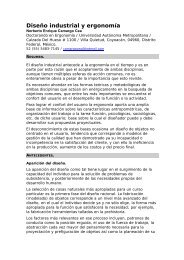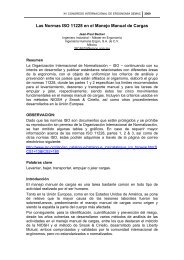ERGONOMÍA OCUPACIONAL - SOCIEDAD DE ERGONOMISTAS ...
ERGONOMÍA OCUPACIONAL - SOCIEDAD DE ERGONOMISTAS ...
ERGONOMÍA OCUPACIONAL - SOCIEDAD DE ERGONOMISTAS ...
Create successful ePaper yourself
Turn your PDF publications into a flip-book with our unique Google optimized e-Paper software.
Ergonomía Ocupacional. Investigaciones y Aplicaciones. Vol 3 2010<br />
lifting, low, that corresponds to lifting among the floor and the height of knuckles, medium, of<br />
height of knuckles to height of shoulders and high, of height of shoulders to arm extended. This<br />
investigation was done with 14 students, female gender, of the program Industrial and Systems<br />
Engineering, with the assumption that they could be part of the workforce of firms established in<br />
the region. As a result of this experiment was observed that the information of maximum<br />
acceptable weight tabulated in liberty mutual tables for similar tasks this experiment are<br />
quantitatively greater and there is sufficient statistical evidence to reject that we can apply it to<br />
working population under study.<br />
Keyword: women lifting weight, women lifting tasks, maximum acceptable weight<br />
1. INTRODUCTION<br />
Webster et al (1994) suggest that low back pain, associated with manual handling of loads,<br />
has been recognized as a major problem worldwide is the most costly injury in the industrial world.<br />
De la Vega (2006), citing The National Institute for Occupational Safety and Health (NIOSH) 1991,<br />
indicates the factors that directly influence the risk of lower back injuries are the weight and<br />
dimensions of the object, the distance is raised, lowered, pulled or pushed, and the repetition rate,<br />
as well as indirect factors such as age and physical condition of the worker. The consequences of<br />
ignoring the weight limit on the repetitive handling of loads can result in decreased performance at<br />
work and presents a risk of back pain that can become a cumulative trauma disorder (CTD) Putz-<br />
Anderson (1994). There are some studies about amount of weight that an individual is capable of<br />
lifting and about task design of the handling manual of loads with minimal risk of injury considering<br />
their characteristics and physical abilities. The reports of these studies represent guides to the<br />
industry which requires manually moving loads repeatedly. Among the most widely used guides<br />
include the NIOSH equation and the Liberty Mutual tables. The first is a tool through which,<br />
considering 7 factors involved in a lifting task, calculate the recommended weight limit (LPR) and,<br />
once known, is calculated the Lifting index that he is the ratio between the load weight and the<br />
recommended weight limit. The values that can take this index may fall into three risk zones,<br />
namely: limited risk (lifting index




